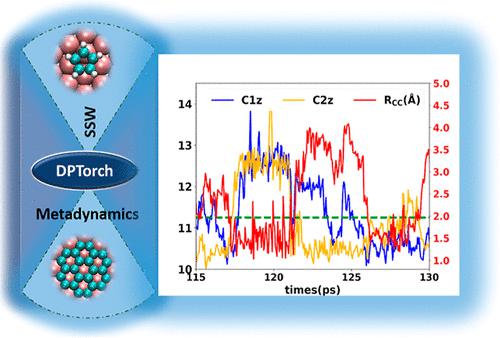当前位置:
X-MOL 学术
›
J. Phys. Chem. C
›
论文详情
Our official English website, www.x-mol.net, welcomes your feedback! (Note: you will need to create a separate account there.)
Hydrocarbon Species on the Cu(111) Surface Studied with a Neural Network Potential
The Journal of Physical Chemistry C ( IF 3.7 ) Pub Date : 2024-03-20 , DOI: 10.1021/acs.jpcc.3c08138 Sen Xu 1 , Liling Wu 2 , Yi Fan 1 , Yufeng Liu 1 , Xiongzhi Zeng 1 , Zhenyu Li 2
The Journal of Physical Chemistry C ( IF 3.7 ) Pub Date : 2024-03-20 , DOI: 10.1021/acs.jpcc.3c08138 Sen Xu 1 , Liling Wu 2 , Yi Fan 1 , Yufeng Liu 1 , Xiongzhi Zeng 1 , Zhenyu Li 2
Affiliation

|
Hydrocarbon species are involved in various surface processes, such as graphene growth on Cu surfaces. A systematic examination of their structures, stability, and reactivity from first principles is essential for understanding the atomic mechanisms of these processes. However, this approach has a substantial computational cost. In this study, we train an accurate Cu–C–H neural network (NN) potential using a homemade deep potential learning platform, DPTorch, which exhibits good linear scalability over thousands of CPU cores and multiple GPUs. The obtained NN potential can accurately reproduce the reaction energy and activation barrier for elementary reactions with hydrocarbon species involved. With such an accurate NN potential, the stochastic surface walking global optimization algorithm is then used to explore stable hydrocarbon structures on the Cu(111) surface. It turns out that hydrogen plays an important role in stabilizing small carbon ring structures. Free energy surfaces are constructed via enhanced sampling using NN potential-based molecular dynamics simulations, which gives a revision to statistically not well-converged free energy barriers predicted previously using ab initio molecular dynamics. At the same time, new pathways are found for both CH and C2 dissociation reactions. These results provide valuable insights into the chemistry of hydrocarbons on the Cu surface.
中文翻译:

用神经网络势研究 Cu(111) 表面上的碳氢化合物种类
碳氢化合物物种参与各种表面过程,例如铜表面上的石墨烯生长。从第一原理系统地检查它们的结构、稳定性和反应性对于理解这些过程的原子机制至关重要。然而,这种方法具有大量的计算成本。在这项研究中,我们使用自制的深度电位学习平台 DPTorch 训练精确的 Cu-C-H 神经网络 (NN) 电位,该平台在数千个 CPU 核心和多个 GPU 上表现出良好的线性可扩展性。获得的神经网络势能准确再现涉及碳氢化合物的基元反应的反应能和活化势垒。凭借如此精确的神经网络势,随机表面行走全局优化算法可用于探索 Cu(111) 表面上的稳定碳氢化合物结构。事实证明,氢在稳定小碳环结构方面发挥着重要作用。自由能表面是通过使用基于神经网络势的分子动力学模拟的增强采样来构建的,这对之前使用从头算分子动力学预测的统计上未很好收敛的自由能势垒进行了修正。同时,发现了CH和C 2解离反应的新途径。这些结果为铜表面碳氢化合物的化学提供了宝贵的见解。
更新日期:2024-03-20
中文翻译:

用神经网络势研究 Cu(111) 表面上的碳氢化合物种类
碳氢化合物物种参与各种表面过程,例如铜表面上的石墨烯生长。从第一原理系统地检查它们的结构、稳定性和反应性对于理解这些过程的原子机制至关重要。然而,这种方法具有大量的计算成本。在这项研究中,我们使用自制的深度电位学习平台 DPTorch 训练精确的 Cu-C-H 神经网络 (NN) 电位,该平台在数千个 CPU 核心和多个 GPU 上表现出良好的线性可扩展性。获得的神经网络势能准确再现涉及碳氢化合物的基元反应的反应能和活化势垒。凭借如此精确的神经网络势,随机表面行走全局优化算法可用于探索 Cu(111) 表面上的稳定碳氢化合物结构。事实证明,氢在稳定小碳环结构方面发挥着重要作用。自由能表面是通过使用基于神经网络势的分子动力学模拟的增强采样来构建的,这对之前使用从头算分子动力学预测的统计上未很好收敛的自由能势垒进行了修正。同时,发现了CH和C 2解离反应的新途径。这些结果为铜表面碳氢化合物的化学提供了宝贵的见解。



























 京公网安备 11010802027423号
京公网安备 11010802027423号